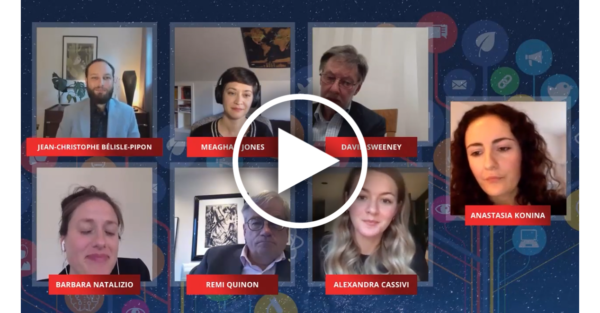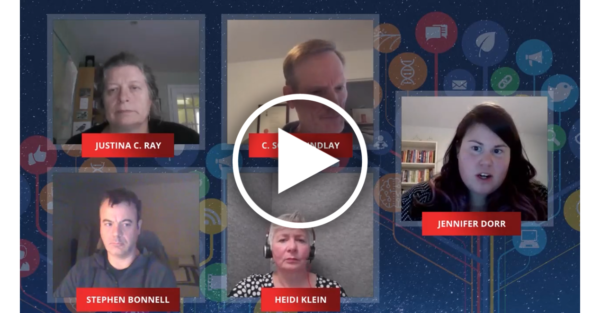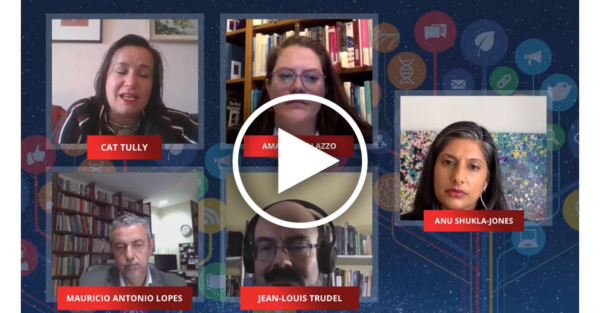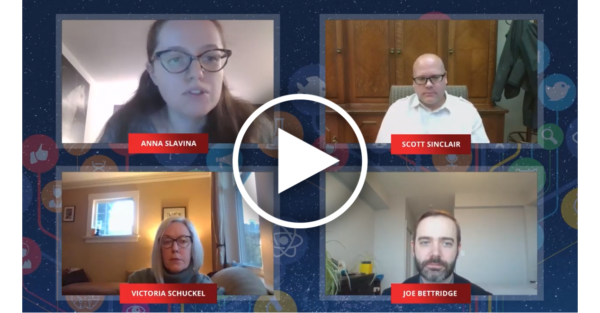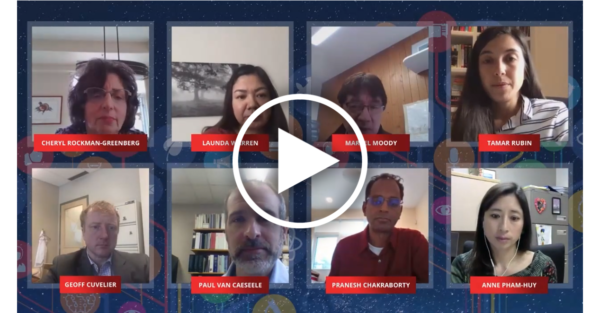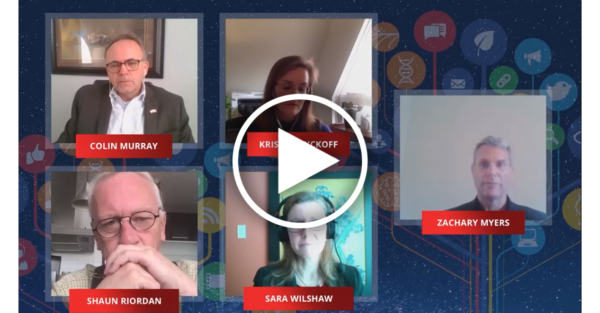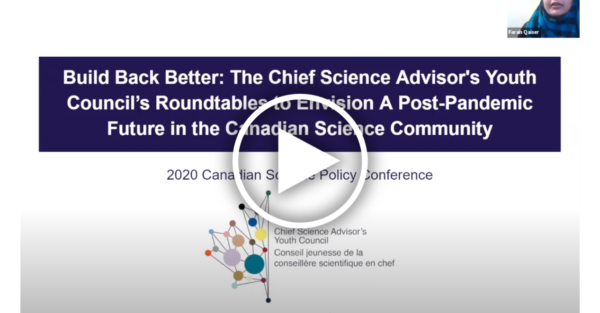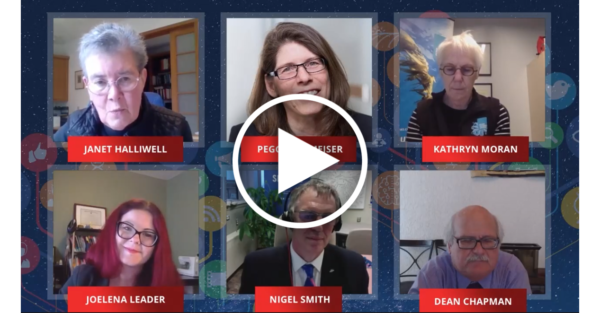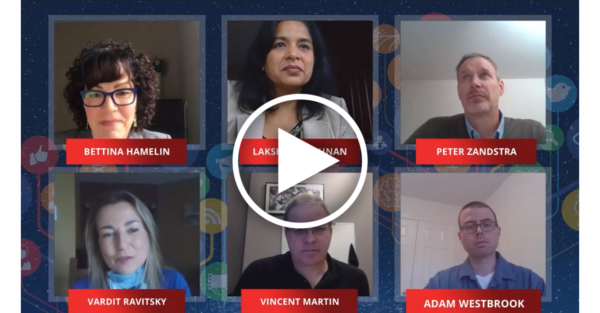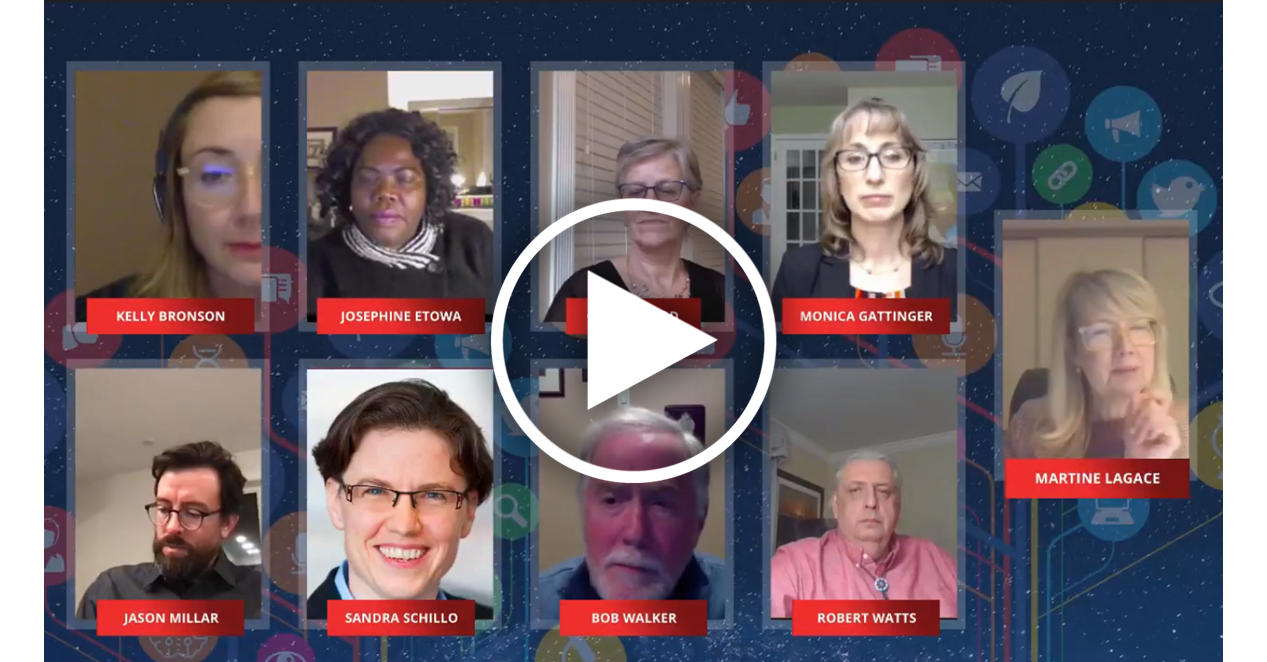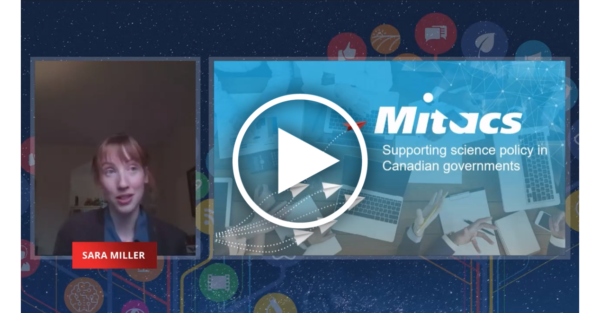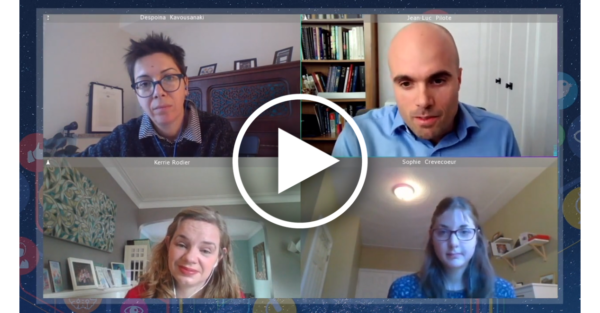The following are the CSPC 2020 panels that cover
Improving Linkages Between Science & Policy
Conference Day 1 – November 16th 2020
Organized by: Fonds de Recherche du Québec
Panelists:
Jean-Christophe Bélisle-Pipon – Visiting Researcher, Harvard University
Meaghan Jones – Assistant Professor, Dept. of Biochemistry and Medical Genetics, Rady Faculty of Health Sciences, Manitoba
David Sweeney – Executive Chair , Research England, UKRI
Barbara Natalizio – Science Program Administrator, Rita Allen Foundation
Rémi Quirion – Chief Scientist of Quebec, Government of Quebec
Alexandra Cassivi – Postdoctoral Researcher, Université Laval
Anastasia Konina – PhD candidate, Université de Montréal
Context: The COVID-19 pandemic has caused major disruptions and presents great challenges to the research ecosystem. This interactive panel examined COVID-19’s negative impacts and engaged the audience in finding effective practices to tackle the effects of the pandemic. The panel will discussed the implementation of the Concordat on Mitigating COVID-19 Pandemic Effects on Research (“COMPEER”) which aims to mobilize the efforts of the global research community. Such engagement is necessary to collectively plan for a “new normal”, ensure that everyone participates in enhancing the academic experience, and conducts research in a more sustainable, responsible, and impactful way.
Takeaways:
- COVID-19 has severely impacted the entire research ecosystem, especially young graduates and professionals, women and racially marginalized groups.
- Economic uncertainties associated with funding cuts, hiring freezes and delays in graduating, as well as fewer physical and social contacts have put more stress on researchers’ mental health, with women and different ethnicities being disproportionately affected.
- Grant proposals need to be reviewed with an equity lens. Institutional leaders and funders should provide value in the research system to facilitate broader experience other than paper publications.
- There should be an open line of communications to hear from people on the ground, to understand their challenges and the kind of support needed.
Actions:
- Funders and universities need to be more supportive and flexible when it comes to grant extensions, reporting deadlines and allowing extra semesters where necessary. Form special groups to look into the impact on ethnic minority groups and providing extra supports when necessary.
- Ensure an open line of communications with people engaged in day-to-day activities, including early career researchers and individuals from historically excluded groups.
- Universities have to ensure broader access to mental health support, both on and off-campus. Researchers should reach out to peer groups and associations to find support for stress management.
- Create multi- and cross-disciplinary career opportunities for young researchers. Make information about career paths and options easily available.
- Ensure increased collaboration among various levels of governments, grant authorities, universities and research associations with representation from all research fields.
- New approaches and examples from other countries should be explored to find solutions for COVID-generated challenges.
Conference Day 4 – November 19th 2020
Organized by: Impact Assessment Agency of Canada
Panelists:
Justina C Ray – President & Senior Scientist, Wildlife Conservation Society Canada
C Scott Findlay – Associate Professor, Department of Biology, University of Ottawa
Stephen Bonnell – Manager, Strategic and Regional Assessments, Impact Assessment Agency of Canada
Heidi Klein – Human and Community Well-being Lead, Two Worlds Consulting
Jennifer Dorr – Manager, Engagement Policy, Impact Assessment Agency of Canada
Context: The precautionary principle as a means of addressing uncertainty is defined and applied differently by many experts, stakeholders and governments. The panel explored the use of the principle in accommodating scientific uncertainty in the field of Impact Assessment. Input gathered will be used to develop operational criteria to assist in operationalizing the precautionary principle in the field of Impact Assessment, and beyond.
Takeaways:
- Taking a precautionary and conservative approach is important in impact assessment, with considerations given to the main value components (e.g., environmental, sociocultural), as well as risk tolerance.
- Multiple knowledge systems (e.g., Indigenous perspective, holistic or systems approach) provide more value that a single perspective in impact assessments.
- A lack of evidence does not indicate an absence of risk.
- An issues-based approach in impact assessments allows for greater consideration of the complexity of the issue itself and a more detailed, applicable solution.
- An important aspect of operationalizing the precautionary approach and asking the right questions is acknowledging that it is intrinsically a value judgment.
- Environmental thresholds, or ‘tipping points’, can be difficult to determine and define, thus rarely used in impact assessments. Environmental thresholds may be the most useful and applicable when considering cumulative effects.
Actions:
- Knowledge holders and scientists should work together to produce the best impact assessments.
- Seek out a range of perspectives, whether they are complementary or divergent, as they highlight different focus areas for different groups. This leads to a more diverse precautionary assessment.
- Qualitative approaches, not just quantitative methods such as matrices, should also be applied in the precautionary principle and impact assessment as a qualitative approach can ensure that issues and effects are evaluated and understood fully, not just quantified using different metrics.
Conference Day 1 – November 17th 2020
Organized by: Ryerson University
Panelists:
Imogen R Coe – President, Canadian Society of Molecular Biosciences
Stephen B Heard – President, Canadian Society for Ecology and Evolution
Charles Bourque – President, Canadian Association for Neuroscience
Hilary Lappin-Scott – President, Federation of European Microbiology Societies (FEMS)
Shohini Ghose – Past President , Canadian Association of Physicists
Susan Amara – President, American Association for the Advancement of Science
Context: In contrast to other parts of the world, science societies in Canada have traditionally had limited interaction with policymakers. This separation of collectives of expertise from policymakers who are tasked with dealing with complex issues such as public health, the economic development and environmental stewardship represents a missed opportunity to bring relevant, timely and expert advice to much needed decision making. The panel discussed ways in which science societies can and should play a significant role in filling the gap between scientists and policymakers.
Takeaways:
- Academic science societies play a vital role in promoting academic research but also have a potential for science advocacy outside of academia. This is particularly important when it comes to communicating in a collective voice with policymakers who often do not understand science or scientific infrastructure.
- Boom and bust cycles of funding of laboratories negatively impact research staff as well as research quality and sustainability. Academic societies can advocate for sustaining science at all levels, including fundamental research which may not have as high a profile as more applied research.
- Engaging academic members, policymakers, stakeholders and advocacy groups can lead to successful results and collective growth (e.g., Brain Canada).
- Academic societies can advance science by addressing constraints that affect the growth of science (e.g., public distrust, lack of stewardship of natural resources).
Actions:
- Academic societies should increasingly advocate changes in policy to promote sustainable funding and increased support for students and researchers at all stages of careers.
- Representatives from federal and local government, industry, universities, advocacy groups, and science policy need to work together for the sustainability of the pipeline in science careers.
- Focus should shift to crafting a long-term plan designed to support staff during downtimes and unforeseen circumstances like the pandemic.
- Academic societies should come together and proactively organize events, workshops and networking sessions to inform public, policymakers and media about important topics that impact society.
- There is a need for establishing dialogue with funding agencies, to promote EDI in STEM. For instance, Canadian Association of Physicists collected and evaluated data on the funding rates by gender to assess the gender-based differences in academic funding.
- Academics and societies need to engage more than just passively providing expert opinions. The aim should be to actively influence policies.
- Academic curriculum should include training graduate students through engagement in policy-related practices, as well as in building a strong science-informed citizenry.
Conference Day 4– November 19th 2020
Organized by: International Institute for Applied Systems Analysis
Panelists:
Anu Shukla-Jones – Senior Policy Analyst, Cross-Functional Policy Mobility Program, Government of Canada
Mauricio Antonio Lopes – Senior Researcher, Brazilian Agricultural Research Corporation – Embrapa
Jean-Louis Trudel – Writer-in-Residence, Institute for Science, Society and Policy, University of Ottawa
Amanda Palazzo – Research Scholar, International Institute for Applied Systems Analysis (IIASA)
Cat Tully – Founder, SOIF
Context: There has never been a time in history when long-term critical thinking has been more needed to address complex challenges. Globally, humanity is facing multifaceted wicked problems, involving multiple stakeholders (often with competing interests), interdependencies and uncertain future prospects. Engaging with these challenges strategically today to identify and prepare for a variety of possible future scenarios can help develop agility in policymaking that reflects today’s volatile and uncertain world. This panel explored some of the practical ways that horizon scanning, foresight, and scenario mapping are being used by academia, industry, governments and international organizations to plan for uncertainties and build towards shared global futures.
Takeaways:
- There is a need to build a range of scenarios and tools to visualize and engage with different and plausible futures using expertise from all stakeholders (e.g., narrative story lines, conceptual maps and images, trend indicators, and quantitative scenarios).
- Co-creating regional futures within a global context requires bringing the right people together across sectors, disciplines, and interests
- Science fiction stories provide effective ways to tell stories about the future: science fiction saw the pandemic coming and people initially turned to it to make sense of the pandemic. (e.g., there was a spike in Google searches for Albert Camus’ the Plague, Stephen King’s The Stand, and the 2011 film Contagion).
- It is important to imagine the future – particularly in the context of anticipating and responding to challenges within agriculture and food systems. As part of this re-imagining, Embrapa has developed an internal intelligence system/think tank capability for Brazil, called Agropensa, that works to identify and observe current and emerging trends, and provide analysis, strategic intelligence and advice that allow Embrapa to engage with these emerging challenges ahead of the curve – to develop innovations/technologies aimed at engaging with future challenges. This includes issues such as climate change driven intensification of biotic and abiotic stresses, with severe consequences to agriculture and food security in the tropical belt of the world.
Actions:
- There is a need for participatory co-development of plausible futures for west Africa, Europe, South America, and globally
- Policymakers should be involved in the development of the scenarios to take ownership.
- There is a need to bring more complexity to research agendas and move from individual disciplinary projects to portfolios to combine and manage a diversity of projects in a more sustainable, collaborative, and systematic way.
- Fine-tune strategies and move away from fragmented agendas to concentrated systemic agendas to tackle future challenges.
- Practitioners in policy planning and strategy making need to involve the next generation to look at the future differently, re-frame dialogue, and develop sustainable foresights for 2045.
- Science fiction can be used as a ‘canary in the coal mine’ and an ‘echo chamber’ that amplifies weak signals about our uncertain futures and re-imagining it (e.g., China is supporting innovations in science fiction and strategic foresight).
Conference Day 1 – November 16th 2020
Organized by: Government of Manitoba
Panelists:
Anna Slavina – Senior Data Analytics Advisor, Dept. of Central Services, Manitoba’s Data Analytics Strategy
Scott Sinclair – Deputy Minister of Central Services
Victoria Schuckel – Executive Director, Research and Innovation, BC Ministry of Health
Joe Bettridge – Practice Lead, TELUS Insights Custom Consulting
Context: Government planning, from everyday decision-making to crises, requires access to timely data and evidence. However, many sectors within government struggle to fulfill their needs for evidence internally. Translating scientific knowledge also presents challenges – academic research is not always intuitively transposable to the policymaking process. Finally, despite the growth of data resources across sectors, these resources remain siloed, impeding fluid collaboration. This panel presented concrete examples of solutions linking science and policy, including programs integrating early-career academics into the policy decision-making arena, collaborations and data sharing across private and public sectors, and programs that support cross-sectoral research and collaboration.
Takeaways
- Bringing scientific evidence to bear on daily decision making in government remains a challenge for several interconnected reasons related to capacity, process and silos across organizations and sectors. Also, individual biases to scientific data and insufficient policies centred on data privacy create additional barriers in implementing evidence and decision-making more broadly.
- The BC Ministry of Health has actively engaged with programs and strategies to increase decision makers’ access to evidence. For example, the Ministry is building a provincial health data infrastructure to enable a much deeper understanding of the effectiveness of various government programs.
- Collaboration between the private sector and government organizations can help the government navigate the impacts of COVID-19. For example, TELUS built a program called “Data for Good’ to enable government and research bodies access data to solve problems related to COVID-19.
- Manitoba has been building internal capacity for data analytics and evidence based decision making by setting up a dedicated team of data scientists.
- Both the government and private sector have encountered public and stakeholder mistrust and non-acceptance of evidence-based decisions, whenever the evidence presented deviates from preconceived notions, organizational processes, or individual biases.
Actions
- To create evidence needed for real-time decision-making that is robust and supported by best practices in the scientific community, rapid-cycle processes need to be built into research programs and government practices.
- Technology such as artificial intelligence and machine learning can make a significant contribution to advancing the use of data science in the public sector. However, more work is required to demonstrate and prove to government the return on investment for incorporating data science into the public sector.
- Data analysis, presentation and visualization are important components that need to be incorporated into evidence-based decision making in the public sector to advance its use of data and to establish public trust in evidence-based decision making.
- To facilitate the implementation of evidence-based decision making more broadly, the government will need to develop internal data analytics capacity and develop more policies on data privacy.
- The government will need to develop an upfront approach to identify what types of evidence people need to make informed decisions for policymaking.
Conference Day 1 – November 17th 2020
Organized by: Takeda Canada
Panelists:
Cheryl Rockman-Greenberg – Distinguished Professor, Department of Pediatrics and Child Health and the Department of Biochemistry and Medical Genetics, University of Manitoba
Launda Warren – Nurse Practitioner, Nisichawayasihk Cree Nation
Marcel Moody – Chief, Nisichawayasihk Cree Nation
Paul Van Caeseele – Medical Director, Cadham Provincial Laboratory
Anne Pham-Huy – Assistant Professor, University of Ottawa
Tamar Rubin – Program Director, Pediatric Allergy and Clinical Immunology, University of Manitoba
Geoff Cuvelier – Director, Pediatric Manitoba Blood and Marrow Transplant Program
Pranesh Chakraborty – Executive Director, Newborn Screening Ontario
Context: The expansion of Manitoba’s NBS program to include universal newborn screening for severe combined immunodeficiency (SCID) is a model case study in how understanding the cause of SCID in Manitoba led to a new program that meets the needs of its citizens. Leveraging their experiences on technological development and community partnership, panelists shared: best practices and solutions regarding equity in research with and for special rare disease populations; how to translate population-specific health research into ‘universal’ health policy; and long-term commitments to health equity and community partnership.
Takeaways:
- Newborn screening (NBS) is a proven health policy strategy for improving patient outcomes in rare genetic diseases through early diagnosis and treatment
- Not all rare genetic diseases are suitable for inclusion in NBS provincial policy: the condition must be treatable with an established follow-up program, testing should be simple and inexpensive and screening should provide a net economic benefit to healthcare. Source: Principles and practice of screening for disease / J. M. G. Wilson, G. Jungner
- For research to be translated into policy, a business case must be built for presentation to government that includes individual and population benefits and demonstrates that sum of all of costs (not just financial) is beneficial to public health.
- “Case-finding” should be a continuing process and not a “once and for all” project. For example, SCID has been found to have population-specific variants due to founder mutations, leading to higher prevalence in certain remote communities in Canada (i.e ADA-SCID in Qikiqtaaluk Inuit, IKBKB CID in Northern Cree, ZAP-70 CID in old colony Mennonite populations). Once a baby with SCID is identified, carrier testing and genetic counselling is offered to the extended family. Source: Severe Combined Immunodeficiency (SCID) in Canadian Children: A National Surveillance Study
- Ontario and Manitoba have successfully implemented changes to SCID NBS health policy that is universal, able to capture population specific variants, and includes infrastructure that addresses a long-term commitment to affected communities
Actions
- Health Equity: SCID NBS should be made universal across Canada (even when certain forms of SCID may be overrepresented in some communities) to account for population migration away from remote communities and across provincial borders (i.e 40% of the Nisichawayasihk Cree Nation live off the reserve. Children born outside of the community fell through the cracks when targeted NBS programs were in place before universal NBS in Manitoba). Source: https://immunodeficiency.ca/newborn-screening-for-scid/
- Screening is “just the beginning”, policies must include the psychosocial needs for affected families and be aimed at improving health with respect, inclusiveness and responsibility. Early engagement and community partnership are necessary to bring awareness to new parents on the importance of disorders that could affect their child’s health.
- Researchers are essential in policy development as they have early insight into public health issues (i.e disproportionate prevalence of diseases) and in many cases, have good connection to the affected communities. If you see the need for policy changes in rare disease, engage with your provincial lab colleagues!
- Infrastructure should be created to optimize all levels of care: surveillance, diagnosis, education, treatment and any unwanted or modifiable effects that arise (vaccine, family carriers, etc.)
- Best practices of western science can be combined with the traditional knowledge of First Nation, Mètis and Inuit healing practices to optimize care (i.e CHEO’s Aakuluk Children’s clinic, NCN Family and Community Wellness Centre).
Conference Day 2 – November 18th 2020
Organized by: Canadian Foundation for Innovation (CFI)
Panelists:
Roseann O’Reilly Runte – President and CEO, Canada Foundation for Innovation (CFI)
Volkmar Dietz – Director, Large Facilities and Basic Research, BMBF Germany
Gail Murphy – Vice-President Research and Innovation, University of British Columbia
Geneviève Tanguay – Vice-President Research, National Research Council of Canada
Fred Wrona – Professor in Integrated Watershed Science, University of Calgary
Context: The potential for increased collaboration between curiosity- and mission-driven research is one of the themes of the upcoming International Conference on Research Infrastructures (ICRI) in 2021. As governments, public health authorities, and community organizations tap into the knowledge and technology development of universities and research institutions, the COVID-19 pandemic has heightened the importance of this type of collaboration. Panelists discussed what organizations are doing currently to merge curiosity- and mission-driven research, what unique and common challenges they face doing so, and how they are strengthening their ability to tackle global issues by sharing their facilities with collaborators.
Takeaways:
- Curiosity-driven research is a precursor to mission-driven research. Both complement each other, and both types of research are supported by research infrastructure.
- By focusing on the knowledge and science gaps that need to be addressed, all relevant research has a contribution to make. Solving complex problems requires approaches that are integrated, multidisciplinary and transdisciplinary, including participation of the social sciences and humanities, as well as other stakeholders and ways of knowing (e.g., Indigenous knowledge).
- Effective collaborations bring all parties together from the onset, including industry, government and academia, with each having a say in governance as well as the design and implementation of research programs and the research infrastructure.
- Research infrastructure that supports collaboration creates inclusive environments for people and ideas not just a space to house equipment.
- Attracting international collaborators can bring expertise to bear on complex research problems while offsetting some of the infrastructure costs.
Actions:
- Garnering support for collaborative research depends on effectively communicating the impacts of research and research infrastructure investments. Frame the stories to connect the dots: these investments in infrastructure and/or people are leading to these economic, social and cultural impacts.
- Research infrastructure needs a sustainable future to support ongoing collaborations. Develop a national roadmap for research infrastructure across the full lifecycle, from idea to building to commissioning through to decommissioning. Include a new approach to address operation and maintenance costs of major science facilities.
- Science should be visible and communicated. Build research infrastructure and facilities in a way that brings in and engages the public. This may include designing labs where people can see science being conducted.
- There is a need to develop better collaboration platforms for research and data sharing. This requires robust and reliable data infrastructure and information and communications technologies with sufficient bandwidth and storage capacity to facilitate data sharing across the country. Platforms also need to consider issues such as security and ethics.
- Strive for optimal performance and sound governance of research Infrastructure and programs.
Conference Day 3 – November 19th 2020
Organized by: Department of National Defence
Panelists:
Zachary Myers – Canadian Armed Forces Engineering Officer, Canadian Armed Forces
Kristin Wycoff – Senior Advisor (U.S.), Defense Research and Development Canada, US Department of Homeland Security Science & Technology
Shaun Riordan – Director of the Chair for Diplomacy and Cyberspace, European Institute of Cyberspace
Sara Wilshaw – Chief Trade Commissioner of Canada and Assistant Deputy Minister, International Business Development, Global Affairs Canada
Colin Murray – Defence R&D Canada Senior Advisor, U.S. Department of Homeland Security Science & Technology Directorate
Context: Within the current world, there are several global issues that require international collaboration if we hope to overcome them. Beyond the immediate crisis of COVID-19, several challenges remain such as climate change, ocean health, access to clean water, and cybersecurity. These challenges transcend national boundaries. As the world opens up afterward COVID-19, what will scientific collaboration look like as we adjust to this new post-pandemic normal? During this new period, the role of policymakers and diplomats will be particularly critical to facilitate the opening of the space for international scientific collaboration to resume.
Takeaways:
- The COVID-19 pandemic has accelerated the move towards digitizing meeting spaces and workflows, increasing the importance of cybersecurity as part of national security.
- The biggest threat to cybersecurity remains the human factor, by way of phishing attacks and psychological manipulation. Efforts to bolster cybersecurity should focus on education and training of personnel at least as much as on technical improvements.
- The shift to digital spaces has also exacerbated various societal issues such as cyber rights, gender rights, and the threat of misinformation.
- A primary role of science diplomats is to be ‘science brokers’ who identify science and innovation that address national issues, even if that science is in another country.
- In a post-pandemic era, which will see reduced international travel, embassies may play a bigger role as centres of diplomacy, including science diplomacy.
- As scientists get more involved in policy matters and speak in support of a policy, they are no longer only scientists but policy advocates, which may affect there standing as detached observers.
Actions:
- Institutions and organizations should be aware of cybersecurity threats and take steps to protect research, researchers and networks.
- Governments should reduce barriers to international collaboration by simplifying processes for sharing data, making use of compatible software, and engaging in science diplomacy.
- Developed nations should develop a degree of ‘humility’, acknowledge other countries may have addressed the COVID-19 Pandemic more effectively, and take steps to learn from their own mistakes and the success of others.
- International organizations such as the United Nations should play a role in developing digital platforms dedicated to diplomacy to replace social media platforms such as Facebook and Twitter.
- In their approaches to ‘building back better’, governments around the world should focus on developing more resilient economies and institutions, and focus on grand issues facing society, such as climate change and social injustice.
Conference Day 1 – November 17th 2020
Organized by: Chief Science Advisor’s Youth Council
Panelists:
Marie-Eve Boulanger – PhD candidate – Institut Quantique, Département de Physique, Université de Sherbrooke
Andréa Cartile – PhD Student, Gina Cody School of Engineering and Computer Science, Concordia University
Landon Getz – PhD. Candidate, Vanier Scholar, and Killam Laureate, Department of Microbiology and Immunology, Dalhousie University
Natasha Jakac-Sinclair – Member, Youth Council, Chief Science Advisor’s Office
Taylor Morriseau – PhD Candidate & CIHR Vanier Scholar, Children’s Hospital Research Institute of Manitoba
Farah Qaiser – Co-Founder, Toronto Science Policy Network
Madison Rilling – Clinical Medical Physicist
Ali Sbayte – Member, Youth Council, Chief Science Advisor’s Office
Sophie Poirier – Member, Youth Council, Chief Science Advisor’s Office
Molly Sung – Co-Founder, Toronto Science Policy Network
Takeaways: coming soon
Conference Day 2 – November 18th 2020
Organized by: Canadian Consortium on Neurodegeneration in Aging
Panelists:
Inbal Itzhak – Knowledge Translation Specialist, Canadian Consortium on Neurodegeneration in Aging (CCNA)
Howard Bergman – Professor, Department of Family Medicine, Geriatric Medicine and Oncology, McGill University; Canadian Academy of Health Sciences (CAHS)
Ginny Lane – Seniors’ Strategic Inititatives Consultant, Community Care Branch, Saskatchewan Ministry of Health
Isabelle Vedel – Assistant Professor, Department of Family Medicine, McGill University
Pamela Jarrett – Geriatrician, Horizon Health Network
Context: The magnitude and complexity of the public health challenges Canada is facing today with dementia prevention, diagnosis, treatment, and care, call for a proactive approach to building strong and long lasting government-academia relationships. The session exposed academia and government stakeholders to each other’s perspective on addressing public health challenges like dementia, and discussed principles for positive and effective government-academia collaboration.
Takeaways:
- It is important for academia and government stakeholders to consider each other’s process, objectives and perspective on addressing public health challenges like dementia.
- Collaboration between government and academia is most effective when:
- There is a long-term meaningful relationship between government and researchers. Hold regular meetings and have established contacts for communication.
- Involvement occurs at various stages of the research. Researchers need to consider how research will be used in practice and policy. Derive questions for research from stakeholders and ensure results can be translated into policy.
- Put in place a project plan that is transparent, aligns expectations, and balances the research process with the need for timely results.
Actions:
- Develop principles for positive and effective government-academia collaborations. Possible principles include:
- Recognize each others needs, and be respectful of each other’s timelines.
- Early engagement and collaboration with all stakeholders (patients, users and different communities) is needed to provide meaningful input.
- Effective communications: e.g., researchers providing short targeted messages when communicating with bureaucrats (i.e., using infographics); and government communicating to researchers about priorities as early as possible.
- Flexibility on part of the researchers: government may need rapid access to information that is not a typical research question.
- Patience is key: it takes time for changes in government policy to reflect research results.
- Research, policy and practice (implementation) need to be a continuous cycle. Clinical leaders need to be part of the equation for effective implementation and evaluation.
Conference Day 1 – November 17th 2020
Organized by: Johnson Shoyama Graduate School of Public Policy, University of Saskatchewan
Panelists:
Janet Halliwell – JE Halliwell Associates Inc.
Joelena Leader – Research Facilitator, Edwards School of Business and Professional Research Associate, Centre for the Study of Science and Innovation Policy
Peggy Schmeiser – Associate Director, Centre for the Study of Science and Innovation Policy, University of Saskatchewan
Nigel Smith – Executive Director, SNOLAB
Kathryn Moran – President and CEO, Ocean Networks Canada
Dean Chapman – Professor, Anatomy, Physiology & Pharmacology, College of Medicine, University of Saskatchewan
Context: This panel explored the capacity, preparedness and needs of Canadian national research facilities and observatories like SNOLAB, Ocean Networks Canada and the Canadian Light Source synchrotron to engage in convergence research to support the development of comprehensive and effective policy strategies for global challenges like COVID-19, climate change and food and water insecurities. The session identified barriers, models and opportunities for better enabling a convergence of expertise through big science facilities and research and building consensus around action items for enabling effective public sector responses to large-scale problems. Many of the issues were highlighted in a CSPC Discussion Paper, found here.
Takeaways:
- Convergence research integrates knowledge from multiple disciplines, including the social sciences and humanities, and diverse stakeholders, including Indigenous knowledge keepers and industry. It can also maximize capacity through the sharing of infrastructure, research facilities and technologies—all with the goal of solving complex challenges such as energy, water, climate, food and health.
- While there is strong support among NRFs for convergence research, the mechanisms, models and funding to enable and cultivate cultures of convergence are not well-established.
- The main barriers for convergence research include: people across disciplines and sectors do not always speak the same language and work in silos; limited funding or allowance in current agreements for convergence research; and a potential lack of coordination to bring people together in the necessary ways. This could be addressed with funding and mechanisms that support multidisciplinary teams and collaborations with other stakeholders.
- The main enablers for convergence research include: intermediaries (e.g., science/innovation hubs); strong leaders who create a culture of collaboration; a common challenge that brings diverse disciplines and sectors together; and, training and engagement opportunities.
- The most effective mechanisms that could be put in place by governments to encourage and support convergence research include: reconsideration of current funding models for national research facilities in ways that support greater research collaboration and mechanisms to bring together researchers and other stakeholders to develop creative ways to tackle grand challenges.
- The most effective mechanisms that could be put in place by research communities and/or universities to encourage and support convergence research include: building networks across multiple disciplines with an explicit focus on convergence research around a common theme or goal; and cross-disciplinary engagement and/or residency opportunities for researchers/scholars in the natural, social sciences and humanities and fine/performing arts to be exposed to each other’s disciplines and work environments.
Actions:
- Establish a working group of government, industry, not-for-profit, and research representatives to explore ways to support convergence research.
- Develop a publicly accessible report or presentation on how to deliver on the promise of convergence research providing possible suggestions for supporting convergence research.
- Develop structures that support productive competition while enabling productive collaboration. These structures need to be nimble enough to be repurposed to address urgent challenges.
- Build and strengthen Canada’s convergence research capacity by enabling opportunities for deeper consideration of the following related factors:
- Roles and mandates of specific NRFs and research personnel;
- Governance models for NRFs including leadership structures and board membership;
- Funding for full lifecycle of NRFs and research projects and collaboration;
- Academic incentives for collaboration across disciplinary boundaries (e.g. tenure and promotion);
- Training and education of current and future researchers;
- Means and obstacles for researchers from diverse fields to interact and collaborate;
- Elaboration of what convergence success looks like, along with ways to measure it; and
- Opportunities and barriers for deeper engagement among all stakeholders including government, industry and community leaders, as well as the Canadian public.
Conference Day 1– November 16th 2020
Organized by: Ontario Genomics
Panelists:
Bettina Hamelin – President & CEO, Ontario Genomics
Lakshmi Krishnan – VP, Life Sciences (Acting); Director General, Human Health Therapeutics, National Research Council
Peter Zandstra – Director, School of Biomedical Engineering, Michael Smith Laboratories
Vardit Ravitsky – Professor, University of Montreal
Vincent Martin – Professor, Concordia University
Adam Westbrook – Metabolic Engineering Lead, Genecis Bioindustries
Context: The “bio-revolution” is here, promising to create US$2-$4 trillion in global value between 2030-2040. By converging genomics and molecular biosciences with engineering, automation, and artificial intelligence, engineering biology emerges as a transformational, productive, and sustainable technology platform to revolutionize healthcare, agriculture, food security and biomanufacturing. Leading G20 jurisdictions are already making significant investment into engineering biology strategies and industries. Canada can and must compete in this global bio-revolution. Members of the Canadian Engineering Biology Steering Committee and broader community discussed the urgency to support Canadian-made engineering biology solutions to remain globally competitive and promote green economic growth and stability in a pandemic and post-pandemic world.
Takeaways:
- Canada already has all the ingredients needed to grow a world-leading engineering biology ecosystem, including: academic and industrial expertise; biofoundaries for researching, testing and scaling-up new genetic products (e.g., new vaccines and therapeutics); and, a national engineering biology steering committee.
- Using engineering biology as a technology platform, Canada can capitalize on existing industry capacity, align academic expertise, and lead in three vertical pillars: circular bioeconomy for biomaterials and minerals; protein manufacturing; and advanced biologics.
- Engineering biology offers many opportunities for public-private sector collaboration.
- This emerging sector still faces governance, regulatory, ethical and societal challenges.
Actions:
- Canada needs a national strategy and action plan to grow Canada’s emerging engineering biology sector. Ensure all stakeholders are engaged.
- Build and fund a cohesive and fully integrated network that supports discovery, commercialization, start-ups, the renewal of traditional industries and the development of skilled talent. This could be led by the new Canadian DNA Engineering Systems Network (Can-DESyNe).
- Create the legal, ethical and flexible regulatory conditions that enable the rapid and safe approval of new engineering biology technologies.
- Establish and support multi-functional biofoundries and scale-up facilities.
- Develop talent and skills for a biomanufacturing future.
- Social acceptance of these new technologies will require open, transparent and ongoing public outreach and community engagement that considers the concerns of all stakeholders.
Resources:
White Paper: Engineering Biology: A platform technology to fuel multi-sector economic recovery and modernize biomanufacturing in Canada. Ontario Genomics and the National Engineering Biology Steering Committee, November, 2020
The Bio Revolution: Innovations transforming economies, societies, and our lives. McKinsey Global Institute, May, 2020
Conference Day 2 – November 17th 2020
Organized by: University of Ottawa
Panelists:
Kelly Bronson – Canada Research Chair in Science and Society, University of Ottawa
Josephine Etowa – Professor, Faculty of Health Sciences, University of Ottawa
Ginny Flood –Chair, Canada’s Clean Resource Innovation Network
Monica Gattinger –Director, Institute for Science, Society and Policy and Professor, University of Ottawa
Martine Lagacé –Associate Vice-President, University of Ottawa
Jason Millar –Canada Research Chair, Ethical Engineering of Robotics and AI, University of Ottawa’s School of Electrical Engineering and Computer Science
Sanda Schillo –Associate Professor, University of Ottawa’s Telfer School of Management
Bob Walker –Retired President & CEO, Atomic Energy of Canada Limited
Robert Watts – Vice-President, Indigenous Relations, Nuclear Waste Management Organization
Context: Meeting the grand challenges of our time – from climate change to COVID-19 – compels Canada to bridge and align science, society and policy imperatives amid polarization, mistrust and misinformation. Durable solutions require deep interdisciplinarity, robust collaboration and authentic knowledge co-production. This panel of leading scholars are pioneering cutting-edge approaches to do just that in energy and climate, artificial intelligence, public health and inclusive innovation.
Takeaways:
- Existing decision-making systems do not always work when it comes to developing and implementing sustainable solutions to address the grand challenges of our time. These grand challenges occur at the societal level but society is often insufficiently engaged in developing solutions, leaving many perspectives excluded from decision-making.
- More inclusive policies can help to integrate community knowledge and concerns in the development of new technologies. Participatory Action Research is one such approach that engages users in the co-creation of knowledge and policies that address social inequities at the community level. Another one is integrating user feedback into technical solutions. Each new technology creates winners and losers with its own ethical and social justice implications. It is important to anticipate those issues before wide-scale implementation, to promote trust in the science, technology and policy.
- Ethics is an umbrella term that encompasses safety and privacy and the environment. Integrating ethics into decision-making about new technologies can be reframed as a creative challenge, adding more issues to the basket of ethical concerns and fosters consideration of who is affected by these technologies. As a producer and consumer of new technologies, government has a crucial role to play.
- Government efforts to involve the public in decision-making on climate change and energy policies have faced criticisms of inequity and a lack of transparency among several groups, including Indigenous peoples, industry, community members and environmental NGOs. Failing to integrate these different worldviews contributes to a loss of confidence in the decision-making process and can undermine reconciliation. If reconciliation has been the vehicle, traditional knowledge is the engine.
Actions:
- There must be a willingness among decision-makers to work as equal partners with people from different sectors and with different worldviews to identify challenges and constructive paths forward.
- Develop tools and methods (e.g., Participatory Action Research) that encourage researchers, particularly those in engineering and artificial intelligence, to engage in policy development, consider ethical concerns and develop solutions that benefit the community.
- A federal government scientific agenda that addresses the grand challenges of our time must help break down silos between disciplines and policy sectors.
- Free and complete access to research data is beneficial for science, public policy, and society. In environmental science and policy, open data systems can enable relevant research and inform evidence-based governmental decisions.
Conference Day 3 – November 19th 2020
Organized by: Mitacs
Panelists:
Sara Miller – Manager of Program Operations , Mitacs
Conference Day 2 – November 18th 2020
Organized by: Public Works Canada
Panelists:
Jean-Luc Pilote – Research Scientist, Geological Survey of Canada, Natural Resources Canada
Sophie Crevecoeur – Research Scientist, Watershed Hydrology and Ecology Research Division, Water Science and Technology branch, Environment and Climate Change Canada
Nathalie Boivin – Senior Science Advisor, Science and Engineering Support and Operations Division, Science and Engineering Directorate, Canada Border Services Agency

